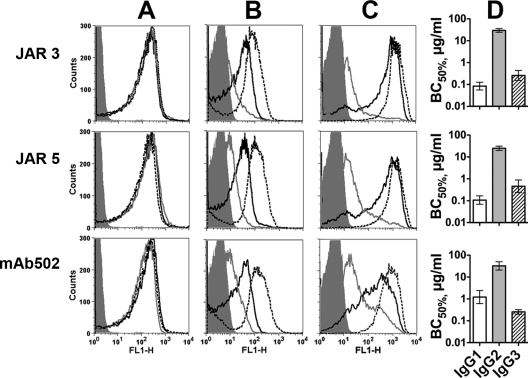Fig 5.
Effect of increased fHbp expression on IgG subclass anti-fHbp complement deposition and bactericidal activity. (A to C) Flow cytometry with live bacterial cells of a mutant strain with overexpressed fHbp (H44/76-OE). (A) Binding of 4 μg of chimeric anti-fHbp MAbs/ml (IgG1, solid black lines; IgG2, gray lines; IgG3, dashed lines; the respective lines are superimposed). An irrelevant MAb (100 μg/ml) was used as a negative control (gray filled histograms). (B and C) Deposition of C4b and C3b, respectively, elicited by 4 μg of anti-fHbp MAb/ml and 10% C6-depleted human serum as a complement source, which also had been depleted of IgG. (D) Anti-fHbp MAb complement-mediated bactericidal activity against mutant strain H44/76-OE. For JAR 3 and JAR 5, the geometric IgG1 concentrations required for 50% bactericidal activity (BC50) (white bars) were lower than the respective IgG3 concentrations (black diagonal hatched bars P ≤ 0.014). For MAb502, the geometric mean BC50 of IgG1 was higher than for IgG3 (P = 0.005). For all three paratopes, the IgG2 BC50 values were higher than the respective IgG1 or IgG3 values (P < 0.0001). The data are from three independent experiments. Error bars represent two standard errors.

